Queen Mary Machinery Spaces and Engines
The Queen Mary as built in 1934 was designed from the very outset
to be a fast ship. Despite her enormous size and displacement, her
designers knew that a fast ship would be a successful ship. This
was already being proven by the German express liners Bremen and
Europa, which had quickly proven themselves in the sea lanes as
the choice for business travelers who needed to cross in the least
amount of time possible. Thus the Queen Mary was to have the latest
in marine propulsion technology. Steam Turbine Engines, 4 in all
each turning its own propellor, powered by a total of 24 water-tube
boilers each heating steam at 700 degrees fahrenheit and at a pressure
of 400 pounds per square inch. .

Queen Mary Bridge
This is the bridge of the Queen Mary. The telegraphs seen here are
shiny brass, while when the ship was in service for Cunard from 1936 to
1968 they were light green. While at the Queen Mary in June, 1996 I
was unable to photograph the bridge as they were filming some sort of
video and the bridge was closed from the public. This was a major
disappointment as one would like to stand in the bridge and imagine
what it must have been like to pilot such a massive ship across the
Atlantic. As it is, I was able to find this photograph of acceptable
quality on a web page image server in Sweden.
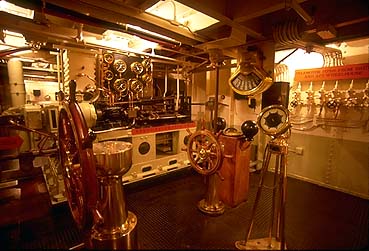
Aft
Engine Room Emergency Steering Station
This area is on what used to be G Deck, the After Engine Room. This
is one of the few remaining engine ares of the ship. After the ship
arrived at Long Beach in 1967, most of the engines were ripped out
to convert those areas of the ship in to a Museum of the Sea which
never fully came to pass. Now those areas once full of "State of the Art"
1930s marine propulsion equipment, remain empty and dark like a closed
up tomb waiting for a ray of sunlight to enter after a thousand years
of abandonment. It is many peoples hope that someday these areas will
house a life-size mockup of a boiler with sound effects and actual steam
to educate visitors on how such a massive ship moved at 32 knots across
a vast ocean carrying 3,200 people. (2002 Update: The Boiler Room Project
is currently being planned with hopes for it to be up and open to the
public in early 2004!) .
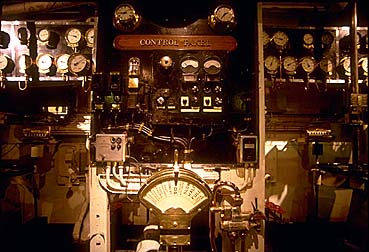
Queen Mary Engine Starting
Platform
Here is one of two identical engine starting platforms. It is here
where the Queen Mary's massive engines were started before a voyage.
Amazingly enough, it looks almost exactly as it did in 1936. Just
pause and imagine to yourself what it must have been like for the
engineers to work in such a place. To start the engines in the Queen
Mary from silence... What sounds did they hear? It would have been
as if one were inside some savage beast coming to life after a long
sleep. The telegraph in the center controlled one out of the four
engines on the Queen Mary. There were four propellors, each driven
by its own engine.
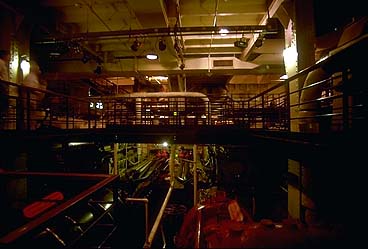
Queen Mary After Engine Room
Here we can get an idea of just a small fraction of what the
engines of the Queen Mary looked like. We are standing in the
After Engine Room, which housed two of the four Steam Turbine
Engines. The other two engines were housed in the Forward Engine
Room, located immediately forward from this room, now empty of
course. These happen to be the inner two, that were run during
the final voyage from Southampton to Long Beach. I wonder how
noisy it was on the high seas at full speed.
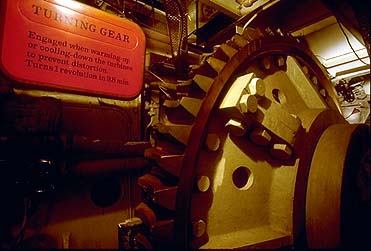
Turbine Turning Gear
As it says in the picture, this massive gear took 9.8 minutes to
make one full revolution. It was used to turn the turbines while the
engines were warming up and cooling down to prevent distortion. The
size of this gear is very telling of the scale of technology present
in the 1930s. "We are building a big ship so we need big parts!" must
have been the axiom. It is very interesting to think that at the time
the engines of the Queen Mary were removed, they were still in perfect
operation condition. When the Queen Elizabeth was sent on her final
voyage to Hong Kong to become a floating university, she steamed out
from Fort Lauderdale, Florida and by the time she was off Cuba she
had lost half of her boilers and had to stop for repairs before being
able to conplete the voyage round the horn to Hong Kong. There she
was converted to a floating university that was to sail all over the
world with students aboard stopping at many ports for field trips.
The Queen Elizabeth burned in Hong Kong harbor and arson was never
ruled out. What was to become "Semester at Sea" was eventually carried
out on a much smaller vessel.
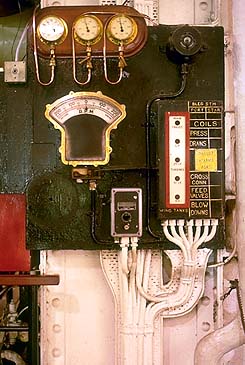
Detail of Controls
Here is a detail of some of the controls immediately adjacent to the
last photograph. It is clear when viewing these areas of the ship how
well they were taken care of during the Queen Mary's days in service
for the Cunard Line. It must have been very difficult to rip out and
destroy such a thing for the salvage workers. Many ask whether the
Queen Mary could ever sail again with all her engines being removed.
I think the main problem would be the hull. The hull of all ships has
leaks. That is why there are bilge pumps. I have heard that the
Queen Mary is no exception, and that there are areas where the hull
plating is rusting badly. But retrofitting modern diesel engines
in the Queen Mary would be next to impossible because of her size.
The QE2, originally built with Steam Turbine Engines in 1968 was
retrofitted with diesel engines in 1986 and many said that if she
were any bigger it would have been impossible. There is only one liner
left of the 1000+ foot class, and that is the Norway, originally the
France. I do not know how much longer she will be at sea, nor if she
is still able to make a profit. But there is talk of new ships being
built to rival even the Norway's size. Only time will tell.







 Return to Main Page
Return to Main Page